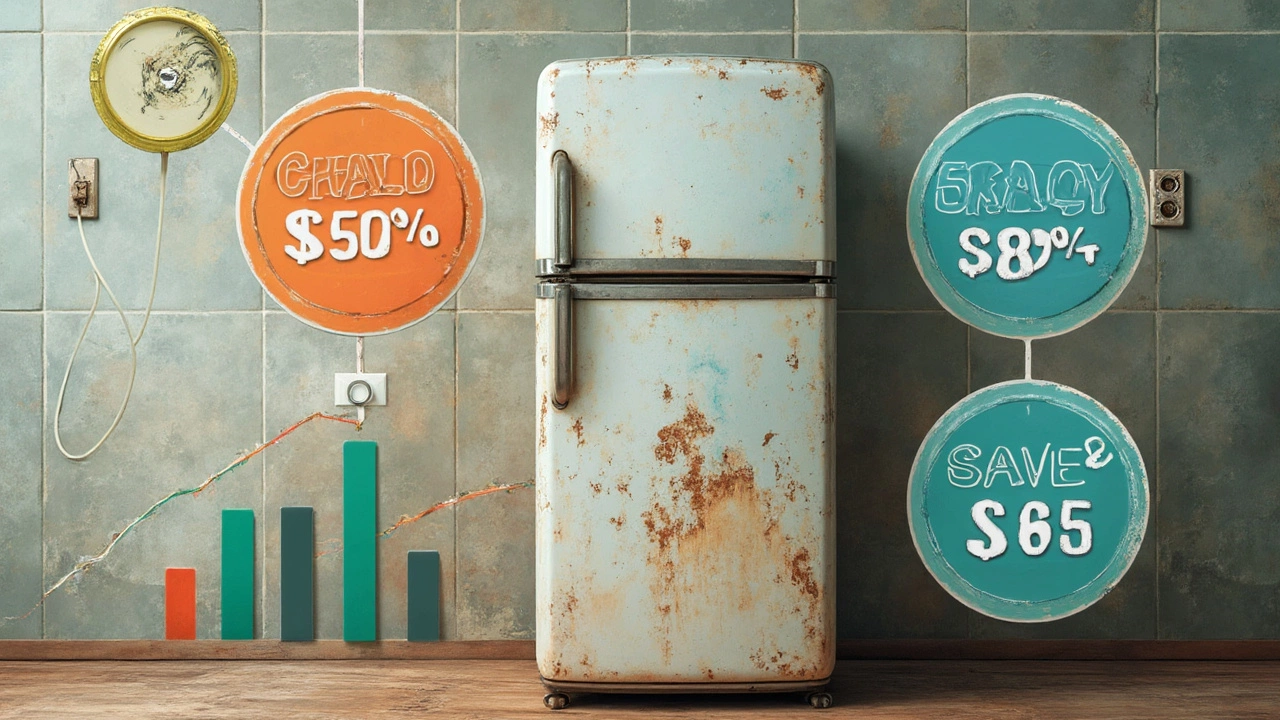
If your fridge is pushing 15 years, you might be wondering if it’s quietly draining your bank account every month. Those extra energy costs sneak up on you, especially since today’s fridges are around twice as efficient as ones built in the late 2000s. A lot changed in appliance standards and technology since then, and that really shows up on your electricity bill.
Most folks don’t realize that an old fridge can use up to twice the electricity of a newer, energy-efficient model. For example, some full-size fridges from 2010 and earlier often gobble 800–1,000 kWh per year or more. Modern fridges of similar size? They usually sip about 400–600 kWh.
Your fridge runs 24/7, so even small boosts in efficiency can add up fast. If you’re on the fence about replacing it, the numbers are worth looking at. There’s a simple way to check your own fridge’s real energy use at home, and the savings from swapping out an old one can be bigger than you’d think.
- How Old Fridges Stack Up
- What’s Changed: Tech and Standards
- How to Check Your Fridge’s Energy Use
- The Real Cost of Keeping an Old Fridge
- When to Ditch It (and What to Look for Next)
How Old Fridges Stack Up
When you look at a 15-year-old fridge, you’re basically staring at a totally different beast compared to what’s out there now. Back in 2010, the average full-size refrigerator used about 900 to 1,200 kilowatt-hours (kWh) per year. Today, similar models sip about half that — around 400 to 600 kWh for the same size and features. That’s a huge monthly cost difference just for keeping your food cold.
Old fridges aren’t just less efficient on paper; their parts wear out over time, making the energy loss even worse. Worn seals, tired compressors, and old insulation all mean your fridge has to work harder, burning even more electricity. If your model came before Energy Star standards got tough (which really kicked in around 2012), you can bet it’s no low-budget runner.
Want some numbers? If you pay the U.S. average of 15 cents per kWh right now, running a 15-year-old fridge could cost $135–$180 a year, while a new one cuts that down to about $60 or less. That’s not pocket change, especially when utility rates creep up every year.
- Older fridges usually lack modern features like variable-speed compressors and improved insulation, which are key for better efficiency.
- A worn-out door gasket (the rubber seal) alone can push up your fridge’s energy use by 10% or more.
- Units made before 2012 might not meet current Energy Star ratings, meaning they’re among the least efficient in your home.
The bottom line: if you’ve got a energy-efficient fridge from the last handful of years, you’re likely saving real money each month. But an old one? It’s probably costing more than you think—both on your energy bill and in its environmental impact.
What’s Changed: Tech and Standards
Back in 2010, nobody was talking about Wi-Fi-enabled fridges or compressors that “learn” how much ice you like. But the real revolution was in how much juice fridges were sucking from the wall. Energy standards got way tighter, and tech had to catch up fast.
One of the biggest game changers was the federal ENERGY STAR® program cranking up its requirements. By 2014, fridges had to use at least 20% less energy than regular models from just a few years prior. Better insulation, smarter compressors, and high-efficiency fans became the new norm. For context, here’s what that looks like in real-world fridge energy use:
| Fridge Year | Typical Yearly Energy Use (kWh) | Energy Star Requirement |
|---|---|---|
| 2005 | ~900-1100 | None or very loose |
| 2010 | ~700-1000 | Mild |
| 2020 | ~350-600 | Strict (20%+ less than federal limit) |
Compressors are a huge part of this shift. Older fridges used basic "on-or-off" compressors that just cycled constantly, burning more power. Today, most new fridges use inverter compressors, which can slow down or speed up as they need—kind of like cruise control. That saves a ton of power, especially when the fridge isn’t working hard.
Seals and insulation also got way better. Modern gaskets and foams block more of that cold air from escaping, so the compressor doesn't have to work overtime—in plain English, your cold beer stays cold with less waste.
To sum it up, the U.S. Department of Energy puts it like this:
"Replacing a refrigerator from 2000 with a new ENERGY STAR certified model can save you more than $200 over five years on energy bills." — Department of Energy
The main takeaway? If you're still running that old fridge, you're probably paying a premium every single month. The newest standards force brands to make energy-efficient fridge models the norm, not the exception.

How to Check Your Fridge’s Energy Use
You don’t have to guess if your old fridge is hogging electricity. There are a few easy ways to see how much energy it’s eating up every year. And the more accurate your info, the clearer your options—do you stick with the fridge you have, or is it time for something better?
The fastest method is grabbing one of those energy meters, like the Kill A Watt. You just unplug your fridge, plug in the meter, and then plug the fridge back in. Leave it running for anywhere from 24 hours to a full week if you want really solid numbers. This shows you the fridge’s actual power use right on the screen.
- Step 1: Unplug your fridge. Fire up your energy meter and connect your fridge through it.
- Step 2: Let it run without interruption. Aim for at least 24 hours for a rough average, but a week gives the best picture.
- Step 3: Read the total kilowatt-hours (kWh) used. Multiply that by 365 (if you measured a single day) to estimate annual use.
If you don’t have a meter, there’s another way. Check inside your fridge for the manufacturer’s label—usually near the top shelf or along a side wall. It should list the fridge’s wattage or yearly energy use. Don’t be surprised if that number looks high; many older models are less efficient than you’d expect.
| Fridge Age | Average Annual Energy Use (kWh) |
|---|---|
| New (2020+) | 400–600 |
| 10–15 Years Old | 800–1,000 |
| 20+ Years Old | 1,200+ |
It’s smart to compare your measured numbers with what a modern energy-efficient fridge actually uses. Most new models have an EnergyGuide label that shows yearly kWh costs and electricity use, so you can see exactly how you’d benefit if you made the swap. Crunching these numbers might just convince you your old fridge’s cool days are over.
The Real Cost of Keeping an Old Fridge
Keeping a 15-year-old refrigerator running might feel like "meh, it still works," but it’s costing you way more than you think. Here’s the thing: Older fridges are usually energy guzzlers. The average fridge built before 2010 can chomp through 900 kilowatt-hours (kWh) per year. With average U.S. electricity prices hovering around 15 cents per kWh, you’re blowing about $135 every year just to keep that one fridge humming. Compare that to a new energy-efficient fridge—these can run for less than $70 a year. That’s almost half the cost, every single year.
The price tag isn’t just about electricity, though. Old fridges are more likely to break or need repairs, and parts can be hard to find. I remember last year my buddy tried to fix his ancient fridge’s compressor—he ended up paying more than half of what a new one costs, just for the part and labor.
Still not sure? Here are some dead-easy ways old refrigerators hit your wallet:
- Higher bills, all year: Those extra bucks add up, especially if rates go up or your utility company charges more in summer.
- More breakdowns: Old seals and motors work harder, so stuff wears out faster.
- Food safety risks: Older units sometimes struggle to stay cold enough, which means your groceries don’t last as long.
If you’ve got a secondary fridge in the garage or basement “just for drinks,” it’s probably a power hog sitting unused most of the day. Energy Star once pointed out that households with two old fridges can easily waste over $200 a year—just by sticking with their old appliances.
Bottom line? That trusty old fridge might look and run fine—but it’s quietly costing you real money, month after month, year after year.

When to Ditch It (and What to Look for Next)
So, is it finally time to kick that aging fridge to the curb? If your fridge is 15 years old or more, it’s probably eating way more electricity than you think. According to the U.S. Department of Energy, refrigerators from 2010 or earlier can cost you $100–$150 per year just for electricity. Newer models? Closer to $30–$60 a year. That’s real money back in your pocket—year after year.
Here’s a quick breakdown to help you decide if you should swap your old fridge for a newer energy-efficient fridge:
- Your fridge is over 10 years old AND your average electric bill just seems high—even if you’ve tried to save power elsewhere.
- You hear the motor running constantly or it’s always running hot to the touch.
- There’s frost buildup or your food isn’t as cold as it should be. Those are signs it’s working harder than it should.
- It’s a second fridge in the garage or basement that you use for just drinks or leftovers—a huge money drain for little benefit.
If you find yourself nodding along to any of those, time to think about an upgrade. But what should you look for next? Simple: focus on the yellow EnergyGuide label. The lower the kWh per year, the better. Look for refrigerators with an ENERGY STAR certification, because they use at least 15% less energy than standard models.
Here’s a quick peek at the difference side by side:
| Fridge Age | Average kWh/Year | Annual Cost* |
|---|---|---|
| 15 years old | 950 | $120 |
| New ENERGY STAR | 450 | $55 |
*Based on $0.13/kWh US average rate.
Bigger isn’t always better. Choose the size you actually need. French door and side-by-side models often use more energy compared to top-freezer types. Consider skipping features like built-in ice makers or water dispensers if you want to cut your bills even more—they can bump up energy use and break more often too.
And here’s a tip Elena found when we shopped together: check for rebates from local utilities when you buy a high-efficiency fridge. Sometimes they’ll even haul away your old one for free.